Child Development: Physical, Social, Emotional, Cognitive and Language Development
VerifiedAdded on 2023/06/14
|10
|3552
|106
AI Summary
This article discusses the different aspects of child development including physical, social, emotional, cognitive and language development. It also explores the impact of poor diet, lack of play, trauma and limited brain stimulation on child development. The article emphasizes on the importance of nurturing and providing a safe and healthy environment for children. It also discusses the Early Years Learning Framework and the Early Childhood Australia Code of Ethics that guide educators and professionals in promoting the holistic development of children.
Contribute Materials
Your contribution can guide someone’s learning journey. Share your
documents today.

QUESTION AND ANSWERS
Secure Best Marks with AI Grader
Need help grading? Try our AI Grader for instant feedback on your assignments.
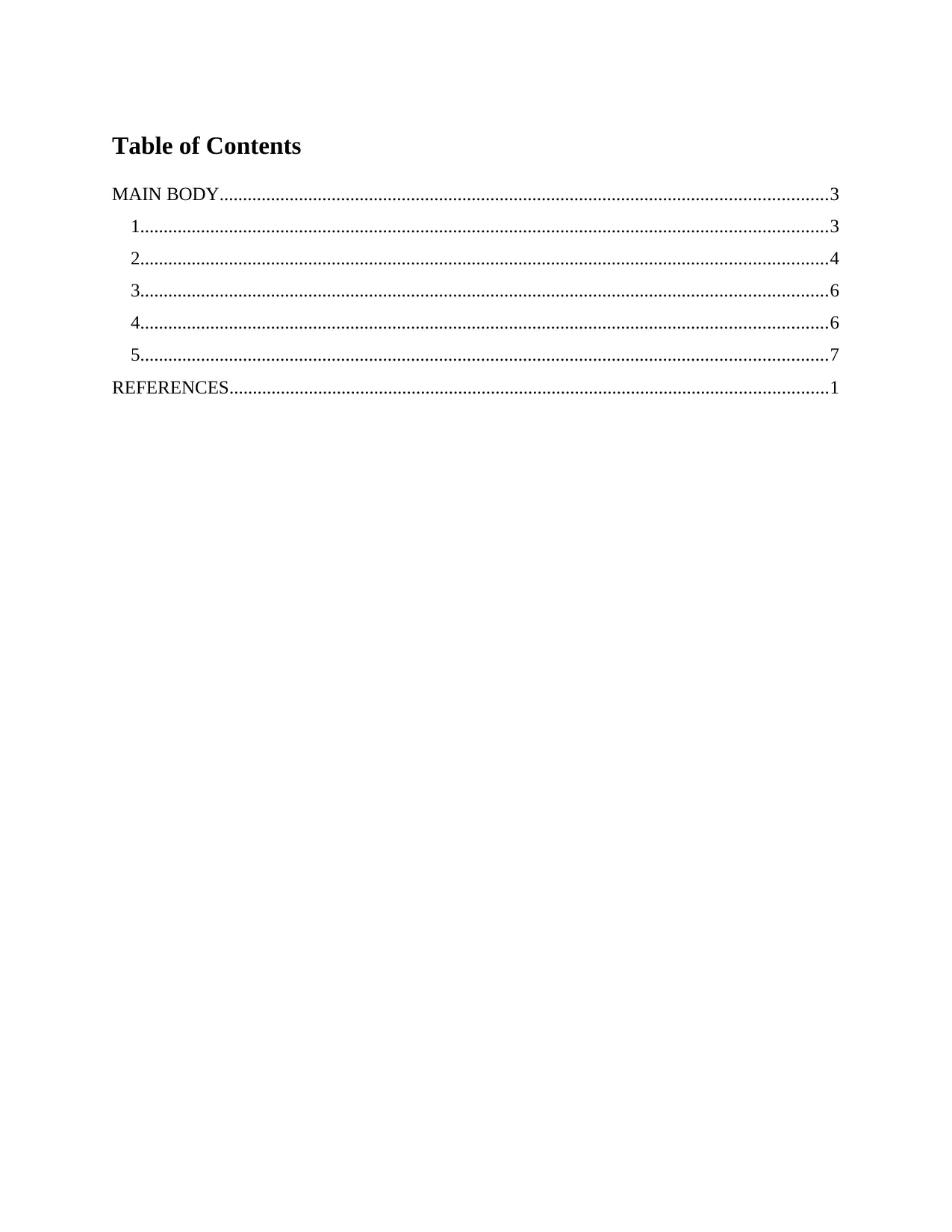
Table of Contents
MAIN BODY..................................................................................................................................3
1...................................................................................................................................................3
2...................................................................................................................................................4
3...................................................................................................................................................6
4...................................................................................................................................................6
5...................................................................................................................................................7
REFERENCES................................................................................................................................1
MAIN BODY..................................................................................................................................3
1...................................................................................................................................................3
2...................................................................................................................................................4
3...................................................................................................................................................6
4...................................................................................................................................................6
5...................................................................................................................................................7
REFERENCES................................................................................................................................1
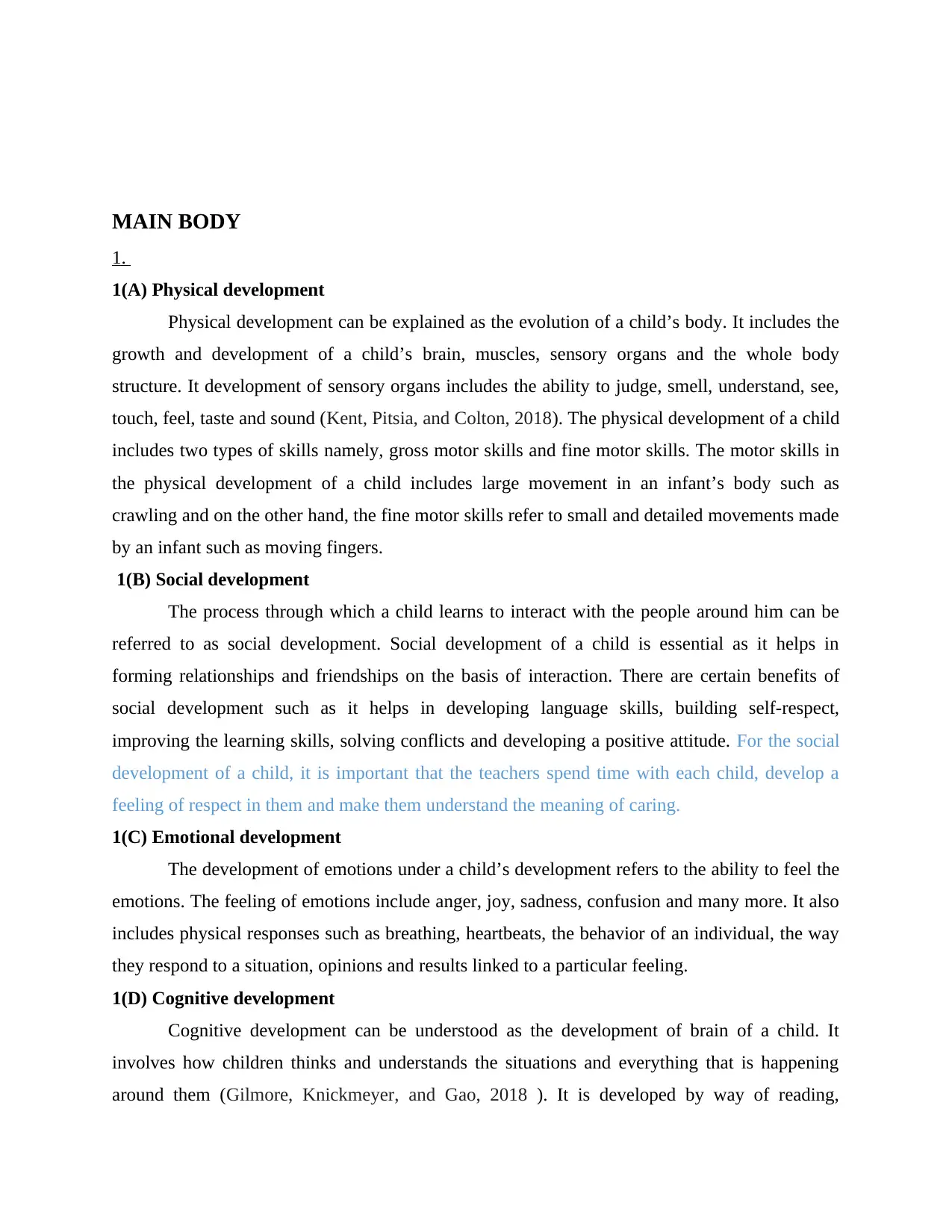
MAIN BODY
1.
1(A) Physical development
Physical development can be explained as the evolution of a child’s body. It includes the
growth and development of a child’s brain, muscles, sensory organs and the whole body
structure. It development of sensory organs includes the ability to judge, smell, understand, see,
touch, feel, taste and sound (Kent, Pitsia, and Colton, 2018). The physical development of a child
includes two types of skills namely, gross motor skills and fine motor skills. The motor skills in
the physical development of a child includes large movement in an infant’s body such as
crawling and on the other hand, the fine motor skills refer to small and detailed movements made
by an infant such as moving fingers.
1(B) Social development
The process through which a child learns to interact with the people around him can be
referred to as social development. Social development of a child is essential as it helps in
forming relationships and friendships on the basis of interaction. There are certain benefits of
social development such as it helps in developing language skills, building self-respect,
improving the learning skills, solving conflicts and developing a positive attitude. For the social
development of a child, it is important that the teachers spend time with each child, develop a
feeling of respect in them and make them understand the meaning of caring.
1(C) Emotional development
The development of emotions under a child’s development refers to the ability to feel the
emotions. The feeling of emotions include anger, joy, sadness, confusion and many more. It also
includes physical responses such as breathing, heartbeats, the behavior of an individual, the way
they respond to a situation, opinions and results linked to a particular feeling.
1(D) Cognitive development
Cognitive development can be understood as the development of brain of a child. It
involves how children thinks and understands the situations and everything that is happening
around them (Gilmore, Knickmeyer, and Gao, 2018 ). It is developed by way of reading,
1.
1(A) Physical development
Physical development can be explained as the evolution of a child’s body. It includes the
growth and development of a child’s brain, muscles, sensory organs and the whole body
structure. It development of sensory organs includes the ability to judge, smell, understand, see,
touch, feel, taste and sound (Kent, Pitsia, and Colton, 2018). The physical development of a child
includes two types of skills namely, gross motor skills and fine motor skills. The motor skills in
the physical development of a child includes large movement in an infant’s body such as
crawling and on the other hand, the fine motor skills refer to small and detailed movements made
by an infant such as moving fingers.
1(B) Social development
The process through which a child learns to interact with the people around him can be
referred to as social development. Social development of a child is essential as it helps in
forming relationships and friendships on the basis of interaction. There are certain benefits of
social development such as it helps in developing language skills, building self-respect,
improving the learning skills, solving conflicts and developing a positive attitude. For the social
development of a child, it is important that the teachers spend time with each child, develop a
feeling of respect in them and make them understand the meaning of caring.
1(C) Emotional development
The development of emotions under a child’s development refers to the ability to feel the
emotions. The feeling of emotions include anger, joy, sadness, confusion and many more. It also
includes physical responses such as breathing, heartbeats, the behavior of an individual, the way
they respond to a situation, opinions and results linked to a particular feeling.
1(D) Cognitive development
Cognitive development can be understood as the development of brain of a child. It
involves how children thinks and understands the situations and everything that is happening
around them (Gilmore, Knickmeyer, and Gao, 2018 ). It is developed by way of reading,

watching, communicating, solving puzzles, playing, singing, talking and many more such
activities.
1(E) Communication/ language development
The process through which a child learns to interact and communicate with people can be
called as language or communication development of a child. A child starts recognizing the
voice of his/her mother during the stage of infancy. They try to catch familiar words, learn to
make different types of sounds such as chuckling, gurgling, mumbling and crying to express
their needs.
2.
2 (A)(i) The play area that I would suggest could be the child’s home or a crèche and the
equipment that promotes the development of gross motor skills will be playing with toys, baby
cars, baby cycles and for fine motor skills, the equipment could be pencil and a paper as it will
move their fingers, colors for finger painting, playing with toy block, building a castle with
blocks and many more (Mal-Ed Network Investigators, 2018).
2 (A)(ii) In order to encourage the spontaneity and increase their physical movement I will
organize plays such as hide and seek, playing with the ball, be it basketball or football, jumping,
hopping, dancing and many more. I will also provide the children with the choice like what they
want to play in order to encourage their playful activities. If I get the opportunity to choose
games for children, I will ensure that the game must not be too easy and should not be too hard.
It will challenge the child’s abilities push them towards making it better.
2(B)(i) I will use my body language and gestures to showcase my interest and respect for the
children, educator and families. The facial expression says a lot about a person’s interest.
2(B)(ii) In order to support the child with understanding and communicating with each other, I
will first try to identify the need of a specific individual. I will try to understand the situation and
determine the issue that the child is facing and then after analyzing the whole situation I will try
and mold my nature so that the child finds himself to be comfortable with me and understands
what I am conveying to help him/her with communicating.
2(B)(iii) Children grasps fast what they see and what they hear. For forming rules and
encouraging something, I can use posters that depicts something important such as washing
hands, I can make use of sign boards, hand draw something to make it easier for the child to
activities.
1(E) Communication/ language development
The process through which a child learns to interact and communicate with people can be
called as language or communication development of a child. A child starts recognizing the
voice of his/her mother during the stage of infancy. They try to catch familiar words, learn to
make different types of sounds such as chuckling, gurgling, mumbling and crying to express
their needs.
2.
2 (A)(i) The play area that I would suggest could be the child’s home or a crèche and the
equipment that promotes the development of gross motor skills will be playing with toys, baby
cars, baby cycles and for fine motor skills, the equipment could be pencil and a paper as it will
move their fingers, colors for finger painting, playing with toy block, building a castle with
blocks and many more (Mal-Ed Network Investigators, 2018).
2 (A)(ii) In order to encourage the spontaneity and increase their physical movement I will
organize plays such as hide and seek, playing with the ball, be it basketball or football, jumping,
hopping, dancing and many more. I will also provide the children with the choice like what they
want to play in order to encourage their playful activities. If I get the opportunity to choose
games for children, I will ensure that the game must not be too easy and should not be too hard.
It will challenge the child’s abilities push them towards making it better.
2(B)(i) I will use my body language and gestures to showcase my interest and respect for the
children, educator and families. The facial expression says a lot about a person’s interest.
2(B)(ii) In order to support the child with understanding and communicating with each other, I
will first try to identify the need of a specific individual. I will try to understand the situation and
determine the issue that the child is facing and then after analyzing the whole situation I will try
and mold my nature so that the child finds himself to be comfortable with me and understands
what I am conveying to help him/her with communicating.
2(B)(iii) Children grasps fast what they see and what they hear. For forming rules and
encouraging something, I can use posters that depicts something important such as washing
hands, I can make use of sign boards, hand draw something to make it easier for the child to
Secure Best Marks with AI Grader
Need help grading? Try our AI Grader for instant feedback on your assignments.
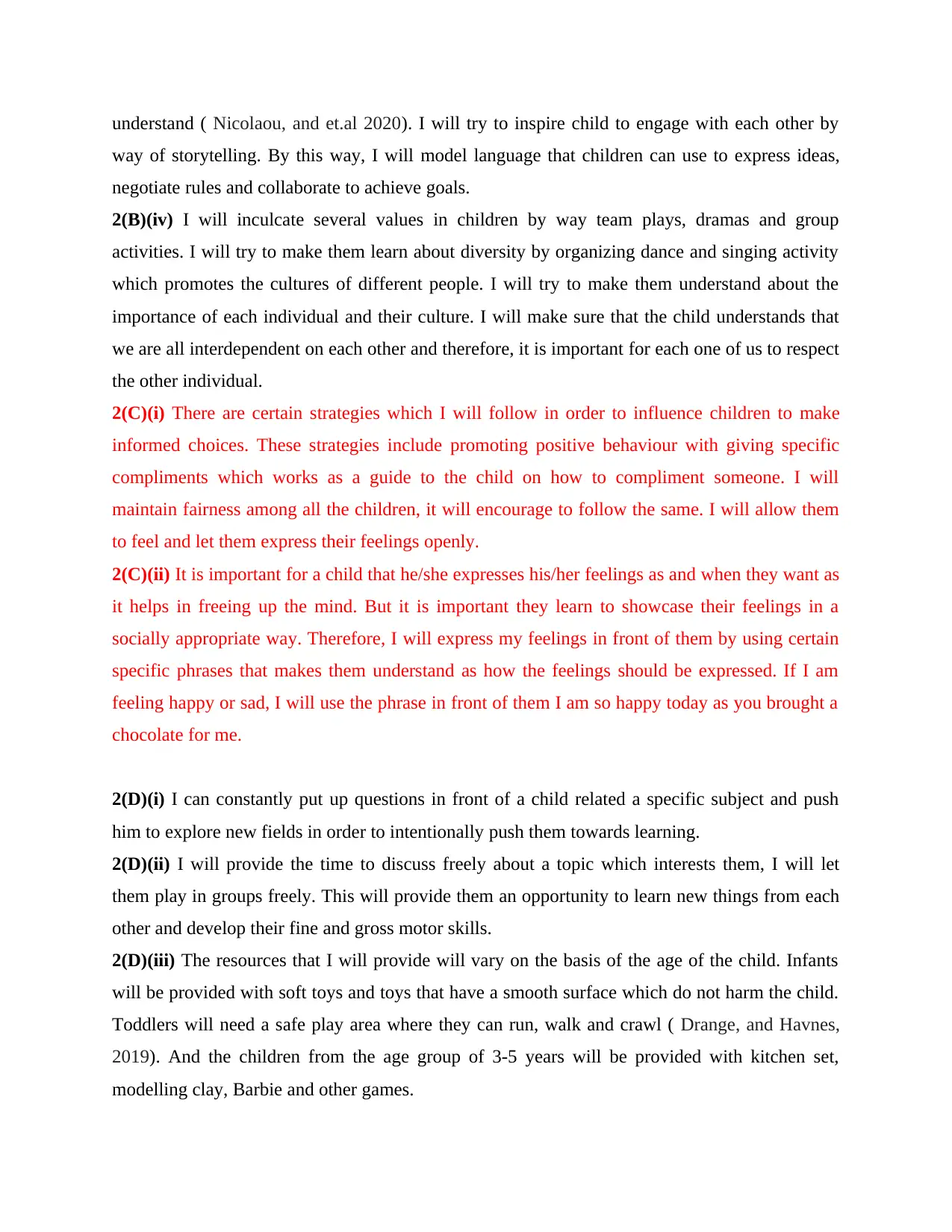
understand ( Nicolaou, and et.al 2020). I will try to inspire child to engage with each other by
way of storytelling. By this way, I will model language that children can use to express ideas,
negotiate rules and collaborate to achieve goals.
2(B)(iv) I will inculcate several values in children by way team plays, dramas and group
activities. I will try to make them learn about diversity by organizing dance and singing activity
which promotes the cultures of different people. I will try to make them understand about the
importance of each individual and their culture. I will make sure that the child understands that
we are all interdependent on each other and therefore, it is important for each one of us to respect
the other individual.
2(C)(i) There are certain strategies which I will follow in order to influence children to make
informed choices. These strategies include promoting positive behaviour with giving specific
compliments which works as a guide to the child on how to compliment someone. I will
maintain fairness among all the children, it will encourage to follow the same. I will allow them
to feel and let them express their feelings openly.
2(C)(ii) It is important for a child that he/she expresses his/her feelings as and when they want as
it helps in freeing up the mind. But it is important they learn to showcase their feelings in a
socially appropriate way. Therefore, I will express my feelings in front of them by using certain
specific phrases that makes them understand as how the feelings should be expressed. If I am
feeling happy or sad, I will use the phrase in front of them I am so happy today as you brought a
chocolate for me.
2(D)(i) I can constantly put up questions in front of a child related a specific subject and push
him to explore new fields in order to intentionally push them towards learning.
2(D)(ii) I will provide the time to discuss freely about a topic which interests them, I will let
them play in groups freely. This will provide them an opportunity to learn new things from each
other and develop their fine and gross motor skills.
2(D)(iii) The resources that I will provide will vary on the basis of the age of the child. Infants
will be provided with soft toys and toys that have a smooth surface which do not harm the child.
Toddlers will need a safe play area where they can run, walk and crawl ( Drange, and Havnes,
2019). And the children from the age group of 3-5 years will be provided with kitchen set,
modelling clay, Barbie and other games.
way of storytelling. By this way, I will model language that children can use to express ideas,
negotiate rules and collaborate to achieve goals.
2(B)(iv) I will inculcate several values in children by way team plays, dramas and group
activities. I will try to make them learn about diversity by organizing dance and singing activity
which promotes the cultures of different people. I will try to make them understand about the
importance of each individual and their culture. I will make sure that the child understands that
we are all interdependent on each other and therefore, it is important for each one of us to respect
the other individual.
2(C)(i) There are certain strategies which I will follow in order to influence children to make
informed choices. These strategies include promoting positive behaviour with giving specific
compliments which works as a guide to the child on how to compliment someone. I will
maintain fairness among all the children, it will encourage to follow the same. I will allow them
to feel and let them express their feelings openly.
2(C)(ii) It is important for a child that he/she expresses his/her feelings as and when they want as
it helps in freeing up the mind. But it is important they learn to showcase their feelings in a
socially appropriate way. Therefore, I will express my feelings in front of them by using certain
specific phrases that makes them understand as how the feelings should be expressed. If I am
feeling happy or sad, I will use the phrase in front of them I am so happy today as you brought a
chocolate for me.
2(D)(i) I can constantly put up questions in front of a child related a specific subject and push
him to explore new fields in order to intentionally push them towards learning.
2(D)(ii) I will provide the time to discuss freely about a topic which interests them, I will let
them play in groups freely. This will provide them an opportunity to learn new things from each
other and develop their fine and gross motor skills.
2(D)(iii) The resources that I will provide will vary on the basis of the age of the child. Infants
will be provided with soft toys and toys that have a smooth surface which do not harm the child.
Toddlers will need a safe play area where they can run, walk and crawl ( Drange, and Havnes,
2019). And the children from the age group of 3-5 years will be provided with kitchen set,
modelling clay, Barbie and other games.

2(E)(i) The type of two-way communication depends on the age of the child. If the child is
between the age group of 3-5 years, I will listen to the child and mold my answers accordingly
and ensure they interest the child. Similarly, if a child is on infant stage, the way communicating
will be mostly through happy expressions.
2(E)(ii) I will gather the children and carry out a group activity in which each and every child
will be given a chance to open up and then discuss them with each other.
2(E)(iii) I can make use of conversations that helps in getting details about what the child is
doing and further putting up open ended questions which motivates them to think and the speak
with their knowledge.
2(1) A child when born, is ready to learn and grasps things that are happening around him. But
the surroundings and the experiences of a child in his early years affects the development and
growth of a child. The main development of a child’s brain takes place in his early years just
after the birth. Therefore, it is important for parents to take care of the needs of the child in terms
of nurturing, care and nutrients.
2(2)(a) Jean Piaget's theory of cognitive development- This theory states that there are four
stages of mental development. First stage is from birth to 2 years. Under this stage, the infants
learn about the world with the help of sensory organs. The second stage is from 2 to 7 years
which involves the development of mental imagination in a child, the third stage is from 7 to 11
years in which children develop a logical reasoning and the fourth stage is from 12 years and
above in which they develop operational thoughts. These stages help in adding knowledge and
understanding and continuously improves them as the child moves across these stages.
(b) Vygotsky’s sociocultural theory of cognitive development- This theory states that social
and cultural environment plays an important role in the cognitive development of children. He
states that it is important for children to interact and communicate with others in order to
enhance their learning. Moreover, he states that the environment in which they grow up
influences their mind and affect what they think, how they behave and how they perceive things.
2(3) The development of a child is affected by certain biological and environmental factors. The
biological factors include factors such as genetics, hormones, health, nutrition. The
environmental factors include temperature, conflicts among the family members, stress, and
happy environment.
between the age group of 3-5 years, I will listen to the child and mold my answers accordingly
and ensure they interest the child. Similarly, if a child is on infant stage, the way communicating
will be mostly through happy expressions.
2(E)(ii) I will gather the children and carry out a group activity in which each and every child
will be given a chance to open up and then discuss them with each other.
2(E)(iii) I can make use of conversations that helps in getting details about what the child is
doing and further putting up open ended questions which motivates them to think and the speak
with their knowledge.
2(1) A child when born, is ready to learn and grasps things that are happening around him. But
the surroundings and the experiences of a child in his early years affects the development and
growth of a child. The main development of a child’s brain takes place in his early years just
after the birth. Therefore, it is important for parents to take care of the needs of the child in terms
of nurturing, care and nutrients.
2(2)(a) Jean Piaget's theory of cognitive development- This theory states that there are four
stages of mental development. First stage is from birth to 2 years. Under this stage, the infants
learn about the world with the help of sensory organs. The second stage is from 2 to 7 years
which involves the development of mental imagination in a child, the third stage is from 7 to 11
years in which children develop a logical reasoning and the fourth stage is from 12 years and
above in which they develop operational thoughts. These stages help in adding knowledge and
understanding and continuously improves them as the child moves across these stages.
(b) Vygotsky’s sociocultural theory of cognitive development- This theory states that social
and cultural environment plays an important role in the cognitive development of children. He
states that it is important for children to interact and communicate with others in order to
enhance their learning. Moreover, he states that the environment in which they grow up
influences their mind and affect what they think, how they behave and how they perceive things.
2(3) The development of a child is affected by certain biological and environmental factors. The
biological factors include factors such as genetics, hormones, health, nutrition. The
environmental factors include temperature, conflicts among the family members, stress, and
happy environment.

3.
3(A) A poor diet can hamper the growth and the development of child in a number of ways. Poor
diet can lead to poor memory and improper development of mental skills, and impaired growth
that means existence of weak bones, muscles, teeth.
3(B) The lack of play in the early developmental years of a child affects the growth of a child. It
hinders the physical development of the body and makes the child prone to change. This lead to
depression, anxiety, isolation and problems with adapting to change in the coming years.
3(C) There are certain consequences of limited brain stimulation on the development of a child.
This affects a child’s skills to manage his emotions, adjusts with people from different cultures,
and leads to immature intellectual skills.
3(D) Lack of resources during the early developmental years of a child affects the health and
brain development of a child. People with low income backgrounds cannot afford to provide the
required nutrients to the child which results in low birthweight, tooth decay and poor general
health.
3(E) Nonexistent and lack of emotional support can lead to destructive outcomes in the process
of child development (Lai, and et.al 2018). Lack of affection and emotional support can result in
depression, low self-confidence, aggressiveness, substance abuse and emotional and mental
disorders.
3(F) Trauma is one factor affects the development of a child in many ways. Children who have
experienced trauma in their early lives face difficulties in learning, memory development,
responding to change, responding to relationships. They also face problems in the academic
curriculum and requires extra attention and care from their teachers as well as their friends.
3(G) Life experiences which creates a negative impact of the minds of children restricts and
hamper the early childhood development. Bad experiences can affect a child’s verbal
communication, problem with focusing on a particular subject, memory disorders, persisting an
abusive nature with friends and family.
4.
4 (1)(A) A sense of belonging and connectedness to the environment refers to developing a
feeling in the minds of the children that they belong here, there are more people available here
which are just like them and they can communicate with them about anything without the feeling
3(A) A poor diet can hamper the growth and the development of child in a number of ways. Poor
diet can lead to poor memory and improper development of mental skills, and impaired growth
that means existence of weak bones, muscles, teeth.
3(B) The lack of play in the early developmental years of a child affects the growth of a child. It
hinders the physical development of the body and makes the child prone to change. This lead to
depression, anxiety, isolation and problems with adapting to change in the coming years.
3(C) There are certain consequences of limited brain stimulation on the development of a child.
This affects a child’s skills to manage his emotions, adjusts with people from different cultures,
and leads to immature intellectual skills.
3(D) Lack of resources during the early developmental years of a child affects the health and
brain development of a child. People with low income backgrounds cannot afford to provide the
required nutrients to the child which results in low birthweight, tooth decay and poor general
health.
3(E) Nonexistent and lack of emotional support can lead to destructive outcomes in the process
of child development (Lai, and et.al 2018). Lack of affection and emotional support can result in
depression, low self-confidence, aggressiveness, substance abuse and emotional and mental
disorders.
3(F) Trauma is one factor affects the development of a child in many ways. Children who have
experienced trauma in their early lives face difficulties in learning, memory development,
responding to change, responding to relationships. They also face problems in the academic
curriculum and requires extra attention and care from their teachers as well as their friends.
3(G) Life experiences which creates a negative impact of the minds of children restricts and
hamper the early childhood development. Bad experiences can affect a child’s verbal
communication, problem with focusing on a particular subject, memory disorders, persisting an
abusive nature with friends and family.
4.
4 (1)(A) A sense of belonging and connectedness to the environment refers to developing a
feeling in the minds of the children that they belong here, there are more people available here
which are just like them and they can communicate with them about anything without the feeling
Paraphrase This Document
Need a fresh take? Get an instant paraphrase of this document with our AI Paraphraser
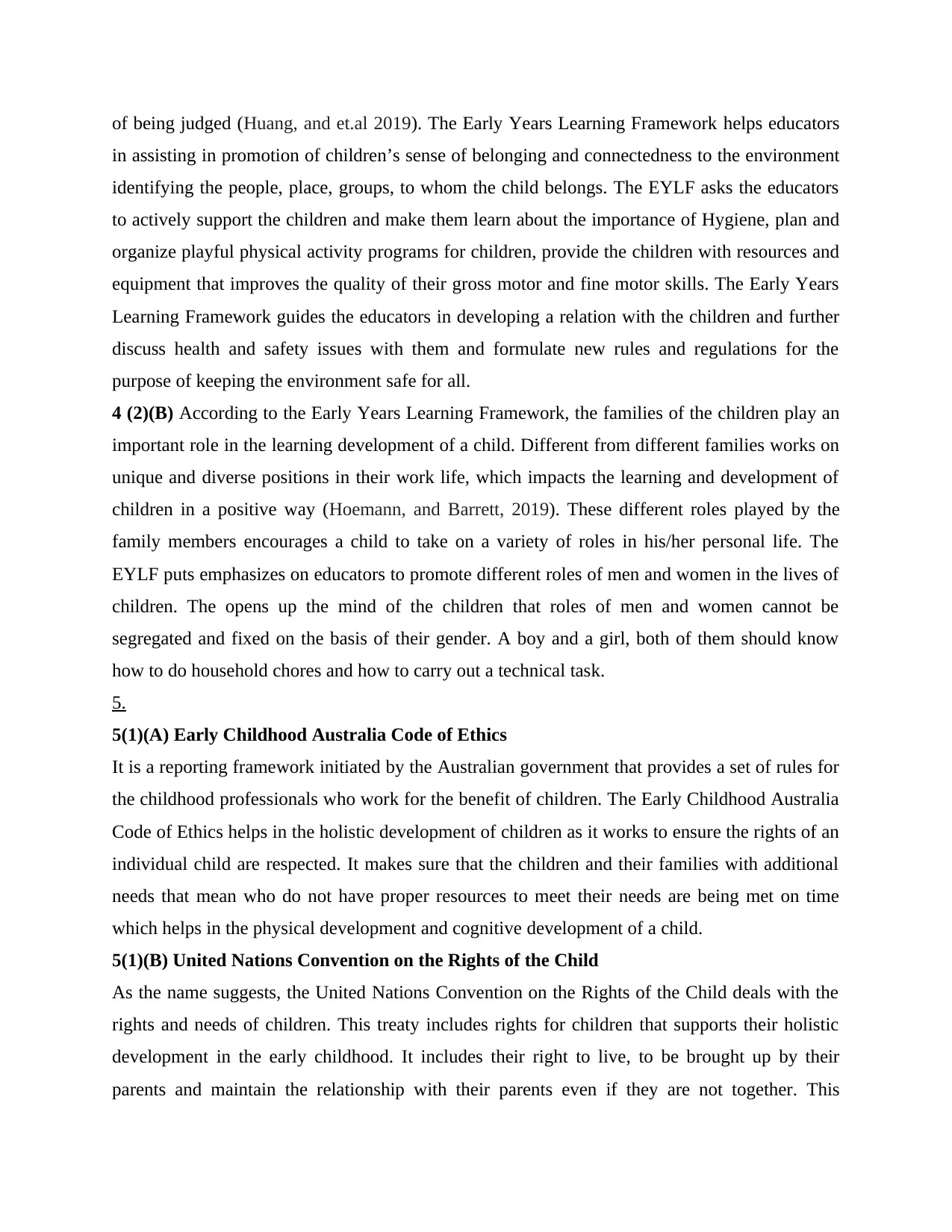
of being judged (Huang, and et.al 2019). The Early Years Learning Framework helps educators
in assisting in promotion of children’s sense of belonging and connectedness to the environment
identifying the people, place, groups, to whom the child belongs. The EYLF asks the educators
to actively support the children and make them learn about the importance of Hygiene, plan and
organize playful physical activity programs for children, provide the children with resources and
equipment that improves the quality of their gross motor and fine motor skills. The Early Years
Learning Framework guides the educators in developing a relation with the children and further
discuss health and safety issues with them and formulate new rules and regulations for the
purpose of keeping the environment safe for all.
4 (2)(B) According to the Early Years Learning Framework, the families of the children play an
important role in the learning development of a child. Different from different families works on
unique and diverse positions in their work life, which impacts the learning and development of
children in a positive way (Hoemann, and Barrett, 2019). These different roles played by the
family members encourages a child to take on a variety of roles in his/her personal life. The
EYLF puts emphasizes on educators to promote different roles of men and women in the lives of
children. The opens up the mind of the children that roles of men and women cannot be
segregated and fixed on the basis of their gender. A boy and a girl, both of them should know
how to do household chores and how to carry out a technical task.
5.
5(1)(A) Early Childhood Australia Code of Ethics
It is a reporting framework initiated by the Australian government that provides a set of rules for
the childhood professionals who work for the benefit of children. The Early Childhood Australia
Code of Ethics helps in the holistic development of children as it works to ensure the rights of an
individual child are respected. It makes sure that the children and their families with additional
needs that mean who do not have proper resources to meet their needs are being met on time
which helps in the physical development and cognitive development of a child.
5(1)(B) United Nations Convention on the Rights of the Child
As the name suggests, the United Nations Convention on the Rights of the Child deals with the
rights and needs of children. This treaty includes rights for children that supports their holistic
development in the early childhood. It includes their right to live, to be brought up by their
parents and maintain the relationship with their parents even if they are not together. This
in assisting in promotion of children’s sense of belonging and connectedness to the environment
identifying the people, place, groups, to whom the child belongs. The EYLF asks the educators
to actively support the children and make them learn about the importance of Hygiene, plan and
organize playful physical activity programs for children, provide the children with resources and
equipment that improves the quality of their gross motor and fine motor skills. The Early Years
Learning Framework guides the educators in developing a relation with the children and further
discuss health and safety issues with them and formulate new rules and regulations for the
purpose of keeping the environment safe for all.
4 (2)(B) According to the Early Years Learning Framework, the families of the children play an
important role in the learning development of a child. Different from different families works on
unique and diverse positions in their work life, which impacts the learning and development of
children in a positive way (Hoemann, and Barrett, 2019). These different roles played by the
family members encourages a child to take on a variety of roles in his/her personal life. The
EYLF puts emphasizes on educators to promote different roles of men and women in the lives of
children. The opens up the mind of the children that roles of men and women cannot be
segregated and fixed on the basis of their gender. A boy and a girl, both of them should know
how to do household chores and how to carry out a technical task.
5.
5(1)(A) Early Childhood Australia Code of Ethics
It is a reporting framework initiated by the Australian government that provides a set of rules for
the childhood professionals who work for the benefit of children. The Early Childhood Australia
Code of Ethics helps in the holistic development of children as it works to ensure the rights of an
individual child are respected. It makes sure that the children and their families with additional
needs that mean who do not have proper resources to meet their needs are being met on time
which helps in the physical development and cognitive development of a child.
5(1)(B) United Nations Convention on the Rights of the Child
As the name suggests, the United Nations Convention on the Rights of the Child deals with the
rights and needs of children. This treaty includes rights for children that supports their holistic
development in the early childhood. It includes their right to live, to be brought up by their
parents and maintain the relationship with their parents even if they are not together. This
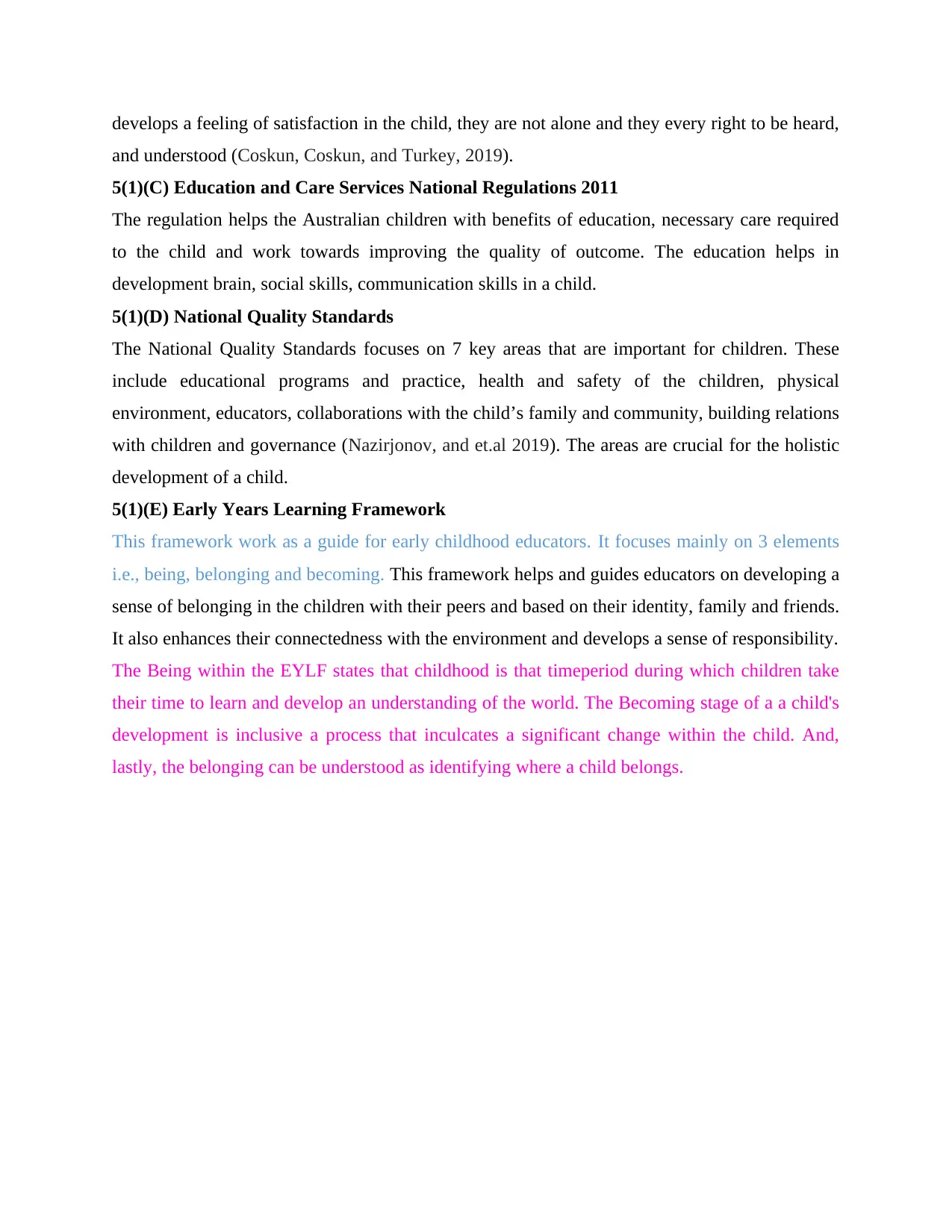
develops a feeling of satisfaction in the child, they are not alone and they every right to be heard,
and understood (Coskun, Coskun, and Turkey, 2019).
5(1)(C) Education and Care Services National Regulations 2011
The regulation helps the Australian children with benefits of education, necessary care required
to the child and work towards improving the quality of outcome. The education helps in
development brain, social skills, communication skills in a child.
5(1)(D) National Quality Standards
The National Quality Standards focuses on 7 key areas that are important for children. These
include educational programs and practice, health and safety of the children, physical
environment, educators, collaborations with the child’s family and community, building relations
with children and governance (Nazirjonov, and et.al 2019). The areas are crucial for the holistic
development of a child.
5(1)(E) Early Years Learning Framework
This framework work as a guide for early childhood educators. It focuses mainly on 3 elements
i.e., being, belonging and becoming. This framework helps and guides educators on developing a
sense of belonging in the children with their peers and based on their identity, family and friends.
It also enhances their connectedness with the environment and develops a sense of responsibility.
The Being within the EYLF states that childhood is that timeperiod during which children take
their time to learn and develop an understanding of the world. The Becoming stage of a a child's
development is inclusive a process that inculcates a significant change within the child. And,
lastly, the belonging can be understood as identifying where a child belongs.
and understood (Coskun, Coskun, and Turkey, 2019).
5(1)(C) Education and Care Services National Regulations 2011
The regulation helps the Australian children with benefits of education, necessary care required
to the child and work towards improving the quality of outcome. The education helps in
development brain, social skills, communication skills in a child.
5(1)(D) National Quality Standards
The National Quality Standards focuses on 7 key areas that are important for children. These
include educational programs and practice, health and safety of the children, physical
environment, educators, collaborations with the child’s family and community, building relations
with children and governance (Nazirjonov, and et.al 2019). The areas are crucial for the holistic
development of a child.
5(1)(E) Early Years Learning Framework
This framework work as a guide for early childhood educators. It focuses mainly on 3 elements
i.e., being, belonging and becoming. This framework helps and guides educators on developing a
sense of belonging in the children with their peers and based on their identity, family and friends.
It also enhances their connectedness with the environment and develops a sense of responsibility.
The Being within the EYLF states that childhood is that timeperiod during which children take
their time to learn and develop an understanding of the world. The Becoming stage of a a child's
development is inclusive a process that inculcates a significant change within the child. And,
lastly, the belonging can be understood as identifying where a child belongs.
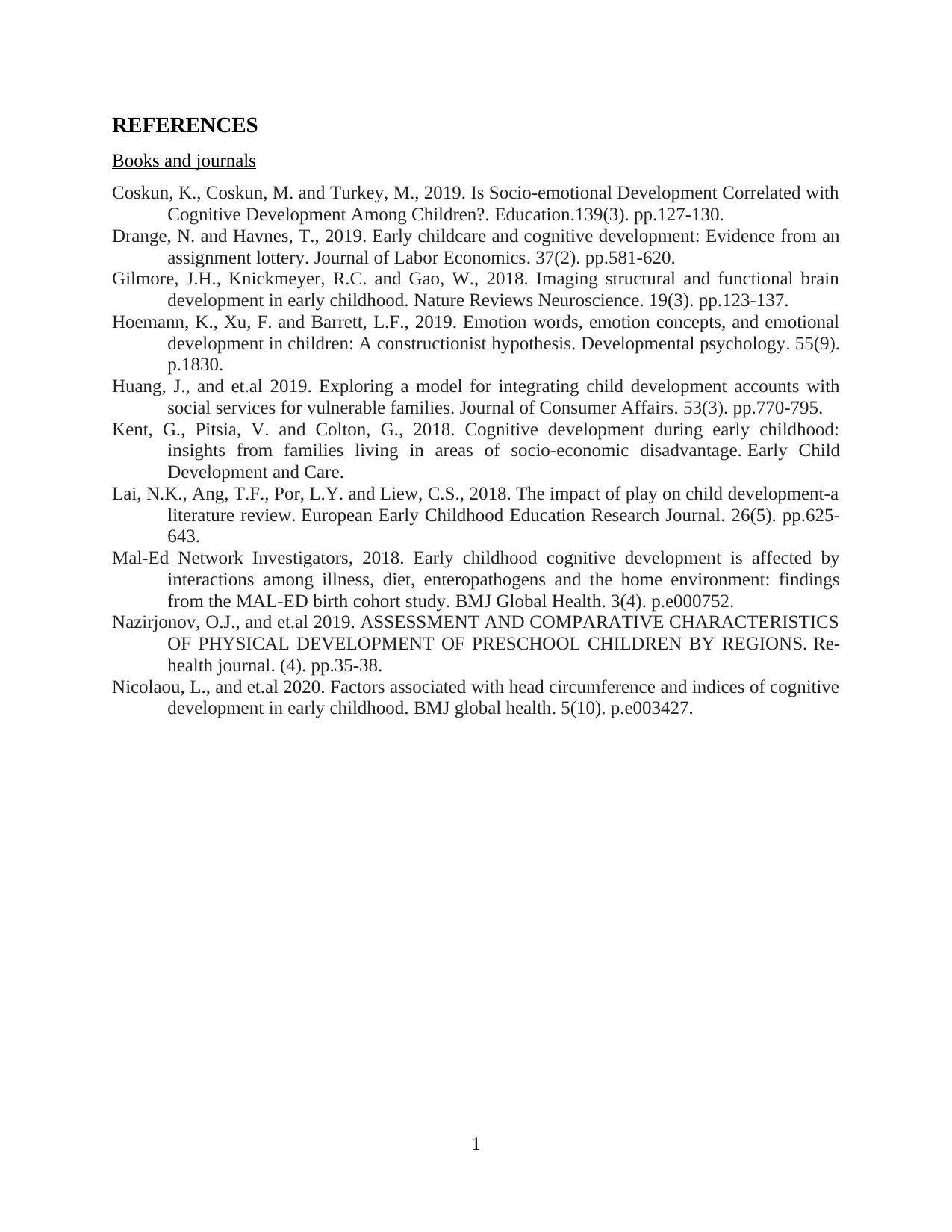
REFERENCES
Books and journals
Coskun, K., Coskun, M. and Turkey, M., 2019. Is Socio-emotional Development Correlated with
Cognitive Development Among Children?. Education.139(3). pp.127-130.
Drange, N. and Havnes, T., 2019. Early childcare and cognitive development: Evidence from an
assignment lottery. Journal of Labor Economics. 37(2). pp.581-620.
Gilmore, J.H., Knickmeyer, R.C. and Gao, W., 2018. Imaging structural and functional brain
development in early childhood. Nature Reviews Neuroscience. 19(3). pp.123-137.
Hoemann, K., Xu, F. and Barrett, L.F., 2019. Emotion words, emotion concepts, and emotional
development in children: A constructionist hypothesis. Developmental psychology. 55(9).
p.1830.
Huang, J., and et.al 2019. Exploring a model for integrating child development accounts with
social services for vulnerable families. Journal of Consumer Affairs. 53(3). pp.770-795.
Kent, G., Pitsia, V. and Colton, G., 2018. Cognitive development during early childhood:
insights from families living in areas of socio-economic disadvantage. Early Child
Development and Care.
Lai, N.K., Ang, T.F., Por, L.Y. and Liew, C.S., 2018. The impact of play on child development-a
literature review. European Early Childhood Education Research Journal. 26(5). pp.625-
643.
Mal-Ed Network Investigators, 2018. Early childhood cognitive development is affected by
interactions among illness, diet, enteropathogens and the home environment: findings
from the MAL-ED birth cohort study. BMJ Global Health. 3(4). p.e000752.
Nazirjonov, O.J., and et.al 2019. ASSESSMENT AND COMPARATIVE CHARACTERISTICS
OF PHYSICAL DEVELOPMENT OF PRESCHOOL CHILDREN BY REGIONS. Re-
health journal. (4). pp.35-38.
Nicolaou, L., and et.al 2020. Factors associated with head circumference and indices of cognitive
development in early childhood. BMJ global health. 5(10). p.e003427.
1
Books and journals
Coskun, K., Coskun, M. and Turkey, M., 2019. Is Socio-emotional Development Correlated with
Cognitive Development Among Children?. Education.139(3). pp.127-130.
Drange, N. and Havnes, T., 2019. Early childcare and cognitive development: Evidence from an
assignment lottery. Journal of Labor Economics. 37(2). pp.581-620.
Gilmore, J.H., Knickmeyer, R.C. and Gao, W., 2018. Imaging structural and functional brain
development in early childhood. Nature Reviews Neuroscience. 19(3). pp.123-137.
Hoemann, K., Xu, F. and Barrett, L.F., 2019. Emotion words, emotion concepts, and emotional
development in children: A constructionist hypothesis. Developmental psychology. 55(9).
p.1830.
Huang, J., and et.al 2019. Exploring a model for integrating child development accounts with
social services for vulnerable families. Journal of Consumer Affairs. 53(3). pp.770-795.
Kent, G., Pitsia, V. and Colton, G., 2018. Cognitive development during early childhood:
insights from families living in areas of socio-economic disadvantage. Early Child
Development and Care.
Lai, N.K., Ang, T.F., Por, L.Y. and Liew, C.S., 2018. The impact of play on child development-a
literature review. European Early Childhood Education Research Journal. 26(5). pp.625-
643.
Mal-Ed Network Investigators, 2018. Early childhood cognitive development is affected by
interactions among illness, diet, enteropathogens and the home environment: findings
from the MAL-ED birth cohort study. BMJ Global Health. 3(4). p.e000752.
Nazirjonov, O.J., and et.al 2019. ASSESSMENT AND COMPARATIVE CHARACTERISTICS
OF PHYSICAL DEVELOPMENT OF PRESCHOOL CHILDREN BY REGIONS. Re-
health journal. (4). pp.35-38.
Nicolaou, L., and et.al 2020. Factors associated with head circumference and indices of cognitive
development in early childhood. BMJ global health. 5(10). p.e003427.
1
1 out of 10
Related Documents
Your All-in-One AI-Powered Toolkit for Academic Success.
+13062052269
info@desklib.com
Available 24*7 on WhatsApp / Email
![[object Object]](/_next/static/media/star-bottom.7253800d.svg)
Unlock your academic potential
© 2024 | Zucol Services PVT LTD | All rights reserved.





